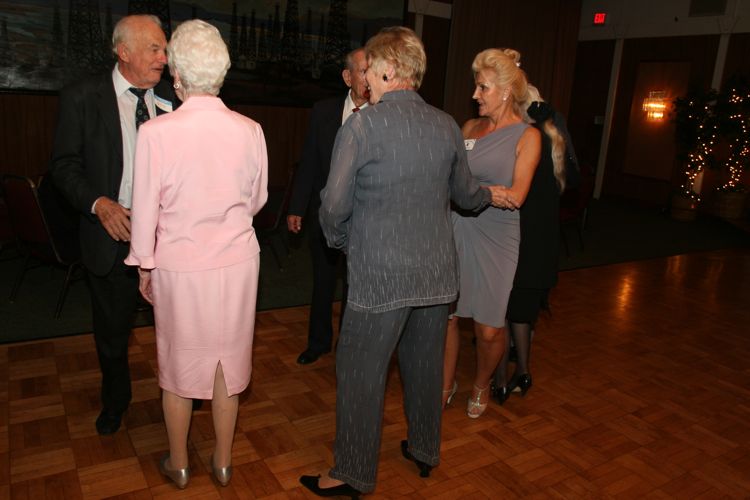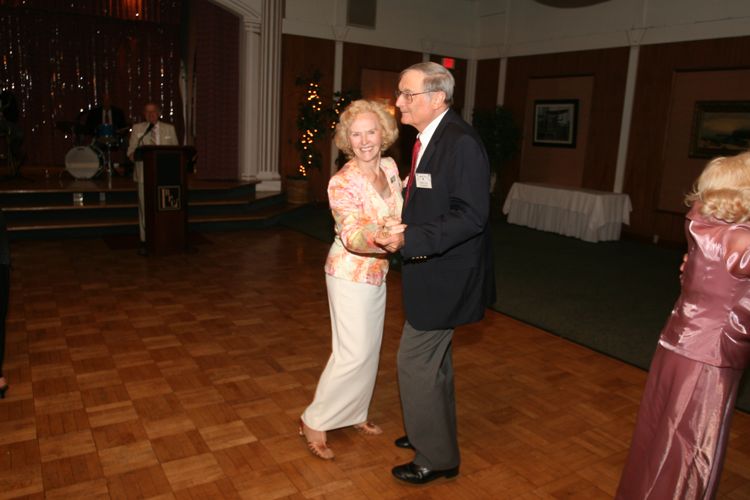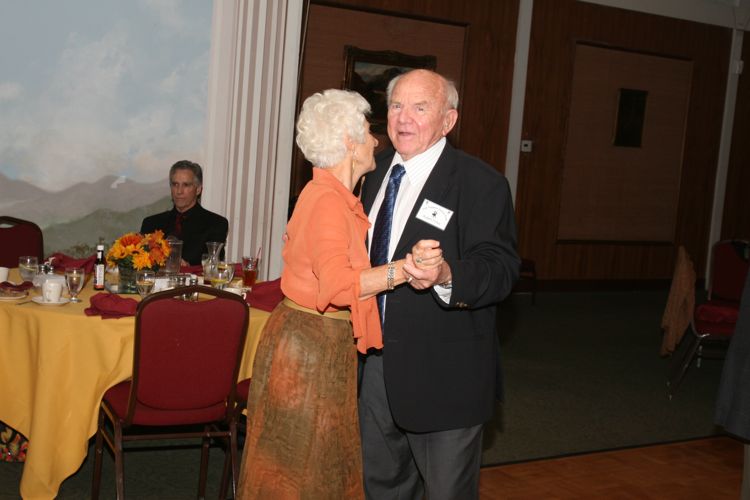Keep On Dancing Mixer Time (Page Three)
(September 24th 2010) Last Updated: 09/11/2019 10:38:AM
Did you know? - The Paul Jones is a mixer dance popular in the first quarter of the 20th century. The Paul Jones may be called for any social dance. The Master of Ceremonies is selected, and at his signal all dancers join their hands to form a circle (or several concentric ones, if crowded), with ladies being to the right of their partners. At the second signal of the Master of Ceremonies the dancers repeatedly do the Grand Right and Left move, well-known in square dancing.
As a result, the ladies move to the left (clockwise) along the circle, while gentlemen move to the right. At the third signal of the M.O.C. dancers dance with the partner whose hand they are holding at the moment. This procedure may be repeated "as the master deems it advisable".







Did you know? - The descriptions of "mixing procedures" vary, however there are several common basic rules.
The basic rule of dance etiquette "thou shalt never say 'no'" is partially waived during certain procedures of the mixer: if you have already danced with the person, you may smile to each other and skip the choice. The reasoning is that the basic purpose of the mixer — to make people dance with many new partners — has the precedence.
In some mixing procedures dancers may get confused and miss a match, therefore often a "lost and found" place is designated (e.g., the centre of the dance circle), where unmatched dancers may find each other.

Don jumped right into the mixer

GiGi and Lucky









Jerry always has a smile
Did you know? - A smile is a facial expression formed by flexing the muscles near both ends of the mouth . The smile can also be found around the eyes (See 'Duchenne smile' below). Among humans, it is customarily an expression denoting pleasure, happiness, or amusement, but can also be an involuntary expression of anxiety, in which case it is known as a grimace. Cross-cultural studies have shown that smiling is a means of communicating emotions throughout the world. But there are large difference between different cultures.
A smile can be spontaneous or artificial (when people feel obliged to smile). Happiness is most often the motivating cause of a smile. Among animals, the exposure of teeth, which may bear a resemblance to a smile, is often used as a threat or warning display—known as a snarl—or a sign of submission. In chimpanzees, it can also be a sign of fear. The study of smiles is a part of gelotology, psychology, and linguistics, comprising various theories of affect, humor, and laughter





No whispering...


Meanwhile At The Table. . . .

Jan is deserting us.... So to speak

That does NOT make the calories go away
More Mixing Required


Did you know? - Raised heels are sometimes claimed to have been a response to the problem of the rider's foot slipping forward in stirrups while riding. The "rider's heel," approximately 1-1/2 inch (4 cm) high, appeared around 1500. The leading edge was canted forward to help grip the stirrup, and the trailing edge was canted forward to prevent the elongated heel from catching on underbrush or rock while backing up, such as in on-foot combat. These features are evident today in riding boots, notably cowboy boots.



Perhaps they are marching???
Did you know? - In the 15th century, chopines, a type of platform shoes, were created in Turkey and were popular throughout Europe until the mid-17th century. Chopines could be seven to eight or even 30 inches high, requiring women to use canes or servants to help them walk. Like pattens, chopines were overshoes, but unlike the pattens, chopines were worn almost exclusively by women (Rexford 2000)[where?]. They were usually designed with cork or wood stacked as the heel.


Good Music

Sound levels seem to be OK
Did you know? - Continual exposure to loud music may result in hearing loss. Depending on the decibel level, the amount of exposure prior to hearing damage varies. Music played at 90 decibels for an 8-hour period each day can cause damage, as can music played at 130 decibels for fewer than four minutes in a day.
Music played at 140 decibels or higher is considered a "danger level." While minor damage caused by lower levels is reversible, major damage caused by extremely loud music may be permanent. The highest "safe" level is considered to be 85 decibels.

Did you know? - High-heeled shoes quickly caught on with the fashion-conscious men and women of the French court, and spread to pockets of nobility in other countries. The term "well-heeled" became synonymous with opulent wealth.[citation needed] Both men and women continued wearing heels as a matter of noble fashion throughout the seventeenth and eighteenth centuries. When the French Revolution drew near, in the late 18th century, the practice of wearing heels fell into decline in France due to its associations with wealth and aristocracy. Throughout most of the 19th century, flat shoes and sandals were usual for both sexes, but the heel resurfaced in fashion during the late 19th century, almost exclusively among women.

Martini Time



Good Idea Gone Bad. . .

Good idea gone too far! - Corn meal? We do not think he is a ballroom dancer, skier maybe
Did you know? - Cornmeal is flour ground from dried maize or American corn. It is a common staple food, and is ground to fine, medium, and coarse consistencies. In the United States, the finely ground cornmeal is also referred to as cornflour. However, the word cornflour denotes cornstarch in recipes from the United Kingdom.



He's still sprinkling powder on the floor

Slip sliding away....

Broom please
Did you know? - A broom is a cleaning tool consisting of stiff fibres attached to, and roughly parallel to, a cylindrical handle, the broomstick. It is commonly used in combination with a dustpan.
In the context of witchcraft, broomstick is likely to refer to the broom as a whole. A smaller whisk broom or brush is sometimes called a duster.
An old form of broom was the besom, which was made simply of twigs tied to a handle, and was relatively inefficient as a cleaning implement. Flat brooms, made of broom corn, were invented by Shakers in the 19th century. Today, they are also commonly made with synthetic bristles.

We escaped from behind the camera




Cooling down






The band is having a lot of fun also
Did you know? - The drum is a member of the percussion group of musical instruments, technically classified as the membranous.Drums consist of at least one membrane, called a drumhead or drum skin, that is stretched over a shell and struck, either directly with the player's hands, or with a drumstick, to produce sound. Other techniques have been used to cause drums to make sound, such as the thumb roll. Drums are the world's oldest and most ubiquitous musical instruments, and the basic design has remained virtually unchanged for thousands of years.
Most drums are considered "untuned instruments", however many modern musicians are beginning to tune drums to songs; Terry Bozzio has constructed a kit using diatonic and chromatically tuned drums. A few types of drums such as timpani are always tuned to a certain pitch. Often, several drums are arranged together to create a drum kit.

Nita gets the "Evil Eye"
from PAul the photographer
It's Getting Late And Time To Go Home


Desert to go???
Did you know? - Leftovers from a restaurant meal may either be left behind to be discarded by the restaurant, or taken away by the diner for later consumption. In order to take the food away, the diner may make a request for it to be packaged. The container used for such leftovers is commonly called a doggy bag or doggie bag; the name comes from the euphemistic pretense that the food will be given to the diner's pet, rather than eaten by a person.
The term doggy bag is preferred over take away or take home bag as it was popularized in the 1970's etiquette columns of many newspapers.[6] Doggy bags are most common in restaurants that offer a take-out food service as well as sit-down meals, and their prevalence as an accepted social custom varies widely by location. In some countries, like France, people would frown upon a diner asking for a doggy bag.



